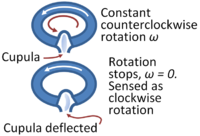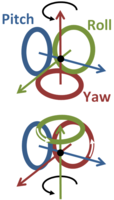User:John R. Brews/Vestibular system: Difference between revisions
Jump to navigation
Jump to search
imported>John R. Brews |
imported>John R. Brews |
||
| Line 4: | Line 4: | ||
|width=200 | |width=200 | ||
|lines=5 | |lines=5 | ||
|Cupula deflection.PNG|When the semicircular canal stops rotating, inertia causes the cupula to register a false rotation in the opposite sense. | |Cupula deflection.PNG|Vestibular system: When the semicircular canal stops rotating, inertia causes the cupula to register a false rotation in the opposite sense. | ||
|Pitch Roll Yaw.PNG|''Top'': The semicircular canals with head erect. ''Bottom'': the canals with head tipped forward. | |Pitch Roll Yaw.PNG|Vestibular system: ''Top'': The semicircular canals with head erect. ''Bottom'': the canals with head tipped forward. | ||
|Vesalius cortex2.png|Vesalius’ illustration of the human cortex. Top panel: Figure 2 of Book 7; Bottom panel: Figure 3 of Book 7. | |Vesalius cortex2.png|Vesalius’ illustration of the human cortex. Top panel: Figure 2 of Book 7; Bottom panel: Figure 3 of Book 7. | ||
}} | }} | ||
Revision as of 12:30, 16 September 2011
Medical
| Medical | |||||||||||||||||||||||||||||
| |||||||||||||||||||||||||||||


